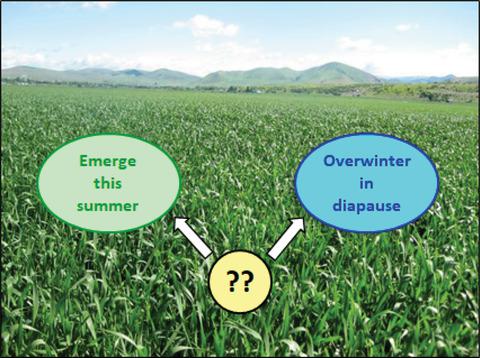当前位置:
X-MOL 学术
›
Entomol. Exp. Appl.
›
论文详情
Our official English website, www.x-mol.net, welcomes your
feedback! (Note: you will need to create a separate account there.)
Partial bivoltinism in a gregarious endoparasitoid: larval diapause as influenced by season and sharing a host
Entomologia Experimentalis et Applicata ( IF 1.4 ) Pub Date : 2020-06-19 , DOI: 10.1111/eea.12942 Edward W. Evans 1
Entomologia Experimentalis et Applicata ( IF 1.4 ) Pub Date : 2020-06-19 , DOI: 10.1111/eea.12942 Edward W. Evans 1
Affiliation

|
The yearly timing of the life cycle of a parasitoid is a key element of its life‐history strategy. I examine here factors influencing the expression of partial bivoltinism in Tetrastichus julis Walker (Hymenoptera: Eulophidae), a specialist parasitoid introduced to North America to attack its univoltine host, the cereal leaf beetle, Oulema melanopus (L.) (Coleoptera: Chrysomelidae). The varying tendency was assessed of individuals of this gregarious larval parasitoid to either emerge as adults in the same summer they mature, or to enter diapause to emerge the following year. Parasitized hosts were obtained by rearing cereal leaf beetles collected as mature larvae from grain fields in northern Utah (western USA) throughout the growing seasons in 2013 and 2014. Cocoons spun by these beetles were held to determine patterns over the spring and summer in the tendency of the parasitoid to forgo larval diapause. A high percentage (nearly 90% in 2013) of parasitoid individuals were found to forgo diapause and emerge in the same summer from earliest maturing hosts. This percentage rapidly declined to 20% or less of individuals forgoing diapause and emerging from cocoons as the summer advanced. The percentage of parasitoid individuals forgoing diapause increased significantly at a given time of season (early or late) as the number of conspecifics with which an individual shared a host larva increased. These results may reflect a trade‐off for individual parasitoids in which greater success in finding – and ovipositing in – host larvae the following spring vs. in summer, is countered by reduced survivorship in diapausing over the winter vs. emerging in the same summer in which the parasitoid matures. Expression of partial bivoltinism of T. julis, as affected strongly by both season and within‐host density, results in high rates of parasitism of cereal leaf beetles both early and late in the season.
中文翻译:

群居体内寄生虫的部分双性化:受季节影响和共享宿主的幼虫滞育
寄生蜂生命周期的年度时间是其生命史策略的关键要素。我在这里检查了影响 Tetrastichus julis Walker(膜翅目:Eulophidae)中部分双性化表达的因素,这是一种被引入北美以攻击其单性寄主谷叶甲虫 Oulema melanopus (L.)(鞘翅目:Chrysomelidae)的专业寄生蜂。评估了这种群居幼虫寄生蜂个体的变化趋势,要么在它们成熟的同一个夏天作为成虫出现,要么在第二年进入滞育状态。寄生宿主是通过在 2013 年和 2014 年整个生长季节饲养从犹他州北部(美国西部)的粮田作为成熟幼虫收集的谷叶甲虫获得的。这些甲虫纺出的茧被用来确定春季和夏季寄生蜂放弃幼虫滞育的趋势模式。发现很大比例(2013 年接近 90%)的拟寄生物个体放弃滞育并在同一个夏天从最早成熟的宿主中出现。随着夏季的临近,这个百分比迅速下降到 20% 或更少的个体放弃滞育和破茧。随着个体与宿主幼虫共享的同种数量增加,在特定季节(早或晚)放弃滞育的拟寄生物个体的百分比显着增加。这些结果可能反映了个体寄生蜂的权衡,其中在第二年春季与夏季相比,在发现和产卵方面取得更大成功,与在寄生蜂成熟的同一个夏季出现相比,冬季滞育的存活率降低。受季节和寄主内密度的强烈影响,T. julis 的部分双伏特化的表达导致谷物叶甲在季节早期和晚期的高寄生率。
更新日期:2020-06-19
中文翻译:

群居体内寄生虫的部分双性化:受季节影响和共享宿主的幼虫滞育
寄生蜂生命周期的年度时间是其生命史策略的关键要素。我在这里检查了影响 Tetrastichus julis Walker(膜翅目:Eulophidae)中部分双性化表达的因素,这是一种被引入北美以攻击其单性寄主谷叶甲虫 Oulema melanopus (L.)(鞘翅目:Chrysomelidae)的专业寄生蜂。评估了这种群居幼虫寄生蜂个体的变化趋势,要么在它们成熟的同一个夏天作为成虫出现,要么在第二年进入滞育状态。寄生宿主是通过在 2013 年和 2014 年整个生长季节饲养从犹他州北部(美国西部)的粮田作为成熟幼虫收集的谷叶甲虫获得的。这些甲虫纺出的茧被用来确定春季和夏季寄生蜂放弃幼虫滞育的趋势模式。发现很大比例(2013 年接近 90%)的拟寄生物个体放弃滞育并在同一个夏天从最早成熟的宿主中出现。随着夏季的临近,这个百分比迅速下降到 20% 或更少的个体放弃滞育和破茧。随着个体与宿主幼虫共享的同种数量增加,在特定季节(早或晚)放弃滞育的拟寄生物个体的百分比显着增加。这些结果可能反映了个体寄生蜂的权衡,其中在第二年春季与夏季相比,在发现和产卵方面取得更大成功,与在寄生蜂成熟的同一个夏季出现相比,冬季滞育的存活率降低。受季节和寄主内密度的强烈影响,T. julis 的部分双伏特化的表达导致谷物叶甲在季节早期和晚期的高寄生率。











































 京公网安备 11010802027423号
京公网安备 11010802027423号